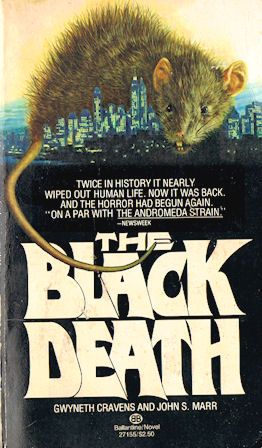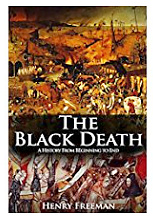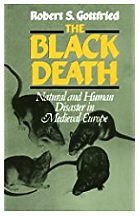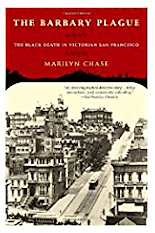






by Gwyneth Cravens and John Marr
Reviewed by Theresa Welsh
|
What is the most feared disaster, capable of wiping out a large population of people in a short time? If we look back through human history to see what has been effective at killing large numbers of people, we would surely find Plague, once called The Black Death, a disease that wiped out at least one-third of the population of Europe between 1347 and 1353. Carried by fleas on rodents, it devastated families, economies, and nations. Bodies piled up and there was no treatment and not enough people left to bury the dead. That was a long time ago accross an ocean. The Return of Deadly PlagueBut what if the Black Death made another appearance, in our time, and settled on the Island of Manhattan, New York City? This paperback book, written in 1977, is about just such an invasion, and it presents a picture of a NYC as it was then, a city in trouble from crime and poverty and diminished city budgets. The story revolves around characters who work for the city Health Department, and decision-makers in Washington, who are faced with the country's largest city in chaos from a deadly epidemic, apparently brought there from California where it had infected a squirrel. A wealthy young girl, visiting there, had tried to nurse the sick squirrel. Returning to NYC, unaware of the deadly bug reproducing inside her, she first coughs on a pimp in the bus station who is looking for naive young girls coming to the big city, and then infects the doorman at her absent parents' fancy apartment building. From these two infections, the tiny organism begins its spread among the human throngs of NYC. In fact, the Black Death has never disappeared, so this is not unrealistic. The disease called Plague is caused by yersinia pestis, described in medical literature as "a Gram-negative, rod-shaped coccobacillus, a facultative anaerobic bacterium that can infect humans and animals." It usually infects fleas that live on rats and then jumps to humans, in which it is usually fatal. The Plague is still in the world today and people still get it, but we do have some medications for fighting it and it has not caused a major epidemic in modern times. There is still no cure once someone has the disease. Trapped on Disease IslandThis book is interesting for a number of reasons. The city Health Department tries to conceal what they eventually discover (to their shock and amazement) is The Plague, but as other cases begin to pop up, word leaks out and panic ensues. One wonders how such a discovery would really be handled. People living in Manhattan want to get out, but people in the other boroughs and New Jersy want to keep them there and act to blockade all tunnels and bridges. Medical authorities order a quarantine. Manhattan is a disease island, with no way off. The most chilling aspect of the story is the reaction of the military advisors to the President to the news that the Plague has come to Manhattan. They insist that the only solution is — get ready for this — to sterilize all life on Manhattan Island! In other words, kill everything living with nerve gas, then when the gas dissipates, go in and bury the bodies and rebuild. Delivering Death from the AirBut what really got to me was their delivery method for the gas. The authors postulate a little flying gizmo they call a "monocopter;" these are controlled from helicopters flying higher. The monocopter is designed like those annoying seed pods that fly off maple trees in springtime. These little gizmos can fly low and be equipped with spray. I had to just stop, in a kind of frozen trance, when I read this, as the thought popped into my head about what we have now but did not have in 1977 — drones! Drones could not only bring in spray to kill fleas and rats (and all the people), but could also bring the disease itself. What if some of the terrorists we're so worried about now sent drones over NYC full of yersina pestis, The Plague? These tiny, deadly organisms are still among us and could still spread through a densely-populated place like Manhattan, killing many thousands of people. Drastic Measures to Protect the UninfectedIn the book, the President ultimately refuses to kill the whole population of Manhattan, but his generals go forward with it anyhow, claiming the President's refusal constitutes a deriliction of duty to protect the American people. However, a sizable collection of people in Manhattan who organized themselves against the general chaos, learn from a city bureaucrat about an unused tunnel running from locations near Central Park to Queens. The leaders of these people have figured out that the government is going to send gas to kill everything on the island and they organize a procession through the tunnel to safety, with hundreds of people who are not sick (as far as they know) emerging from the tunnel onto the green stretch of cemeteries of Queens. Still no Effective Prevention or TreatmentI found this to be an entertaining, but also scary, book about something that might be even more possible today than it was in the late 70s. The authors provide a lot of information about Plague, past epidemics and how the disease does its work. They discuss two forms: bubonic and pneumonic. The book says there is a vaccine against the bubonic form, but the disease usually migrates to the pneumonic form and the vaccine becomes ineffective. However, apparently today there is no vaccine in use. Wikipedia says vaccine for Plague has been taken off the market because it was not very effective and had bad side effects. The picture of New York City in this book as a poor city full of slums and trash-filled streets, is a study in contrasts to the more prosperous, clean and attractive city it is today. But the danger of an epidemic infecting Manhattan and the island being sealed and "sterilized" seems like a scenario that could actually happen. The authors treat the Plague organism as if it had a purpose or intention of its own. They end their tale with these ominous words: If it had chosen to continue, nothing could have halted its course. It vanished as sudenly as it had come. And nothing could prevent its return. Look for The Black Death online or at your local used book sale. I found my copy at a Rummage Sale. |
Books About Click a book to go to its Amazon page     |
 |
 |